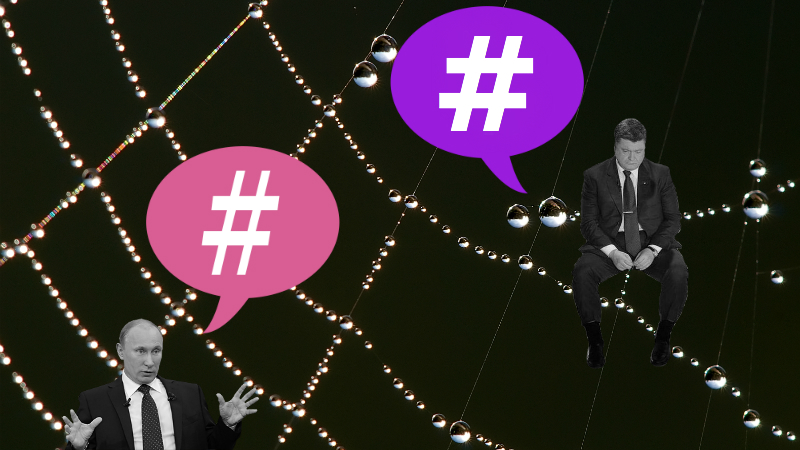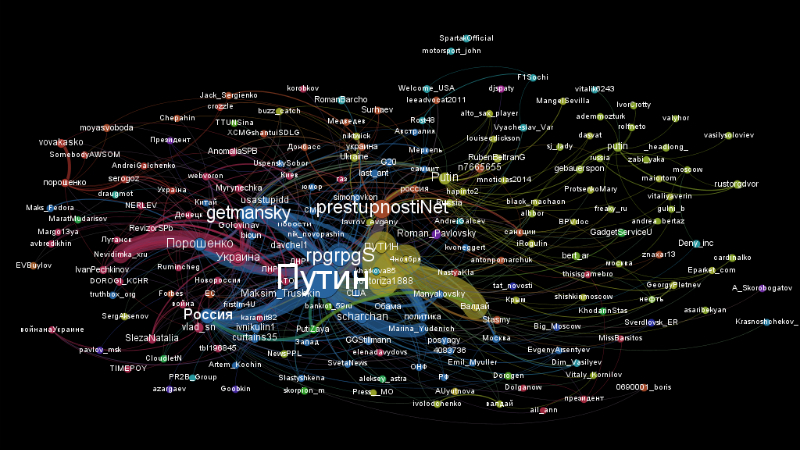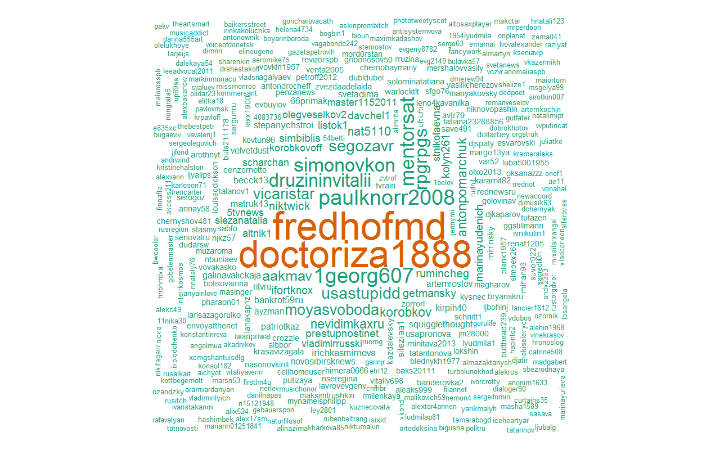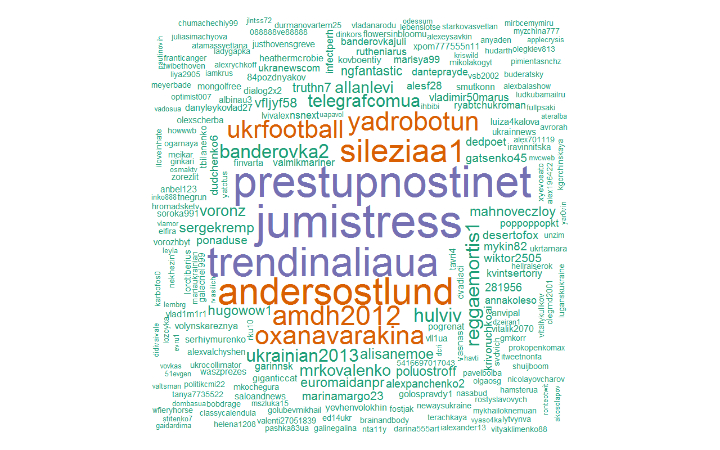
Connections between Twitter users and the hashtags they use might reveal interesting information. Images mixed by Tetyana Lokot.
This article is part of a citizen-media data-analysis project, a collaboration between RuNet Echo and the Maryland Institute for Technology in the Humanities. Explore the complete article series on the All the Presidents’ Tweets page.
We've already had a first look at the smaller dataset from the six-million sample, filtered by country code for a glimpse of tweets from Russia and Ukraine. Over 6,000 tweets with country code “UA” (Ukraine) and almost 8,500 tweets with country code “RU” (Russia) turned out to contain one or more of our designated keywords: poroshenko, putin, порошенко, путин and путін.
Although a much smaller sample, these two bundles of tweets give us a snapshot of the Russian and Ukrainian Twitter spheres during a period of several weeks in the fall of 2014. One of the ways to examine this snapshot is to look at the Russian and Ukrainian tweets as networks connecting individual users, and the relationships behind those connections. The best way to represent such networks visually is through the use of network graphs.
The two network graphs below reveal the associations between individual Twitter users and the hashtags they include in their tweets, both of which are shown as circular nodes. The size of each hashtag node indicates how often it was used in our sample of tweets for each country. The color coding represents clusters of hashtag usage by groups of individual accounts, whose nodes are sized according to their level of contribution to each hashtag.

User-hashtag network graph for the Russian tweets sample (country code “ru”). Image by Lawrence Alexander.
In the graph of Russian users for our particular sample, there is a large blue cluster where activity focuses around the associated dominant hashtags #путин (“Putin”) and #Россия (“Russia”). Also visible in this area, but ranking lower, are the Russian hashtags for “USA,” “Obama,” and “politics” (“политика”).
Notable contributors to the Russia-centered blue cluster include journalist Konstantin Getmansky, and pro-Russian commentators Pavel Ryzhevsky and Maksim Trushkin. Their prominence in this network graph reflects their centrality in the Russia-centered discussion in our sample, but does not, of course, reflect the general Russian Twitter situation, which for all we know, had different users dominating the Putin/Poroshenko discourse at various times.
By contrast, Russian Twitter activity around Ukraine-related hashtags (such as #Порошенко (“Poroshenko”) and #Украина (“Ukraine”)) in our sample is confined to the smaller magenta region on the left. To the right of the main blue cluster, discourse tends to focus on Putin's 2014 Valdai speech.

User-hashtag network graph for the Ukrainian tweets sample (country code “ua”). Image by Lawrence Alexander.
In the Ukrainian sample, hashtag discourse for Putin and Poroshenko during our sample period centers around the accounts of two local news agencies, both prolific on Twitter: PrestupnostiNet (which is also somewhat prominent in the Russian tweet sample) and telegraf.com.ua. Interestingly, Ukrainians seem to use the hashtag for Putin (#путин) slightly more than the one for their own president, Poroshenko.
In both graphs, hashtag communities tend to cluster by language. English hashtag contributors are mostly found around the upper right regions, a notable example being Ukraine army officer and journalist Viktor Kovalenko. Key topics among English-speaking Ukrainian users include Ukraine, Germany, the Kremlin and Putin.
Content analysis studies of Twitter tell us that relying on hashtag usage as a sole measure of influence in a network may lead to a fair amount of bias, as some users employ hashtags a lot more methodically than others, and some don't use them at all. For example, in the Russian sample, top network users Getmansky, Trushkin, and Ryzhevsky include hashtags in almost every tweet, so their prominence in the graph—e.g., through their contributions to #путин (“Putin”) and #Россия (“Russia”)—can partly be attributed to this deliberate hashtags use.
We can, however, add a second layer of analysis to discern the relative influence of individual users in a particular network. With the help of username clouds, we can also rank the Twitter users in each country sample based on the number of their tweets—with and without hashtags. Again, this only tells us which users with country codes for Russia or Ukraine were most prolific in a given sample in the fall of 2014. But while we cannot make overarching judgements about user networks and top users, we can spot some interesting trends.

User cloud weighed by tweet volume for the Russian tweets sample (country code “ru”). Image by Lawrence Alexander.
A notable trend in the top Russian user set is the prominence of deleted/renamed or seemingly fake accounts. Account @fredhofmd no longer exists (its owner, a prolific tweeter claiming to be a Western security specialist based in Russia, has apparently changed his Twitter handle to @infoagestrategy); @doctoriza1888 is an automated bot that repeatedly spams hashtags with YouTube videos; @1georg607 tweets exclusively headlines and links from segodnya.ru; and @usastupidd is an anti-US trolling account.

User cloud weighed by tweet volume for the Ukrainian tweets sample (country code “ua”). Image by Lawrence Alexander.
The top Ukrainian user set includes some accounts which generally tweet (and retweet) a lot about current events, such as @jumistress, @sileziaa1, @yadrobotun and @prestupnostinet, so that is reflected in our sample. Other top users include a Twitter trends bot (automated), but also journalists working in Ukraine like Anna Dombrovskaya and prominent commentators such as Anders Ostlund, a Swedish public figure living in Ukraine.
Our two country samples might not be wholly reflective of the larger Russia-Ukraine Twitter discourse space, but they give us a fairly good idea of who was tweeting about Putin and Poroshenko in the fall of 2014, and what kinds of users and hashtags may have dominated the discussion.







